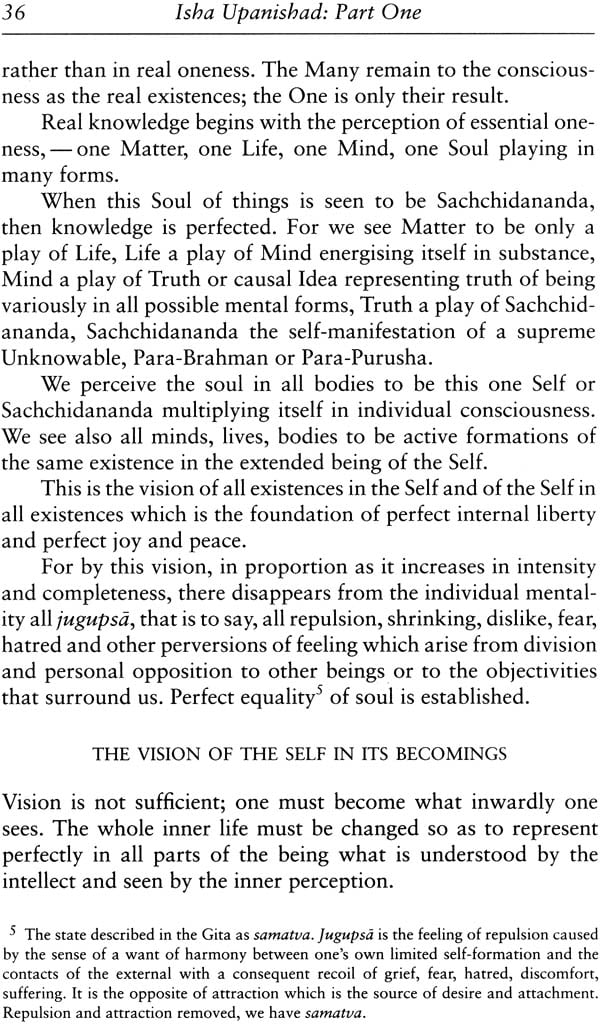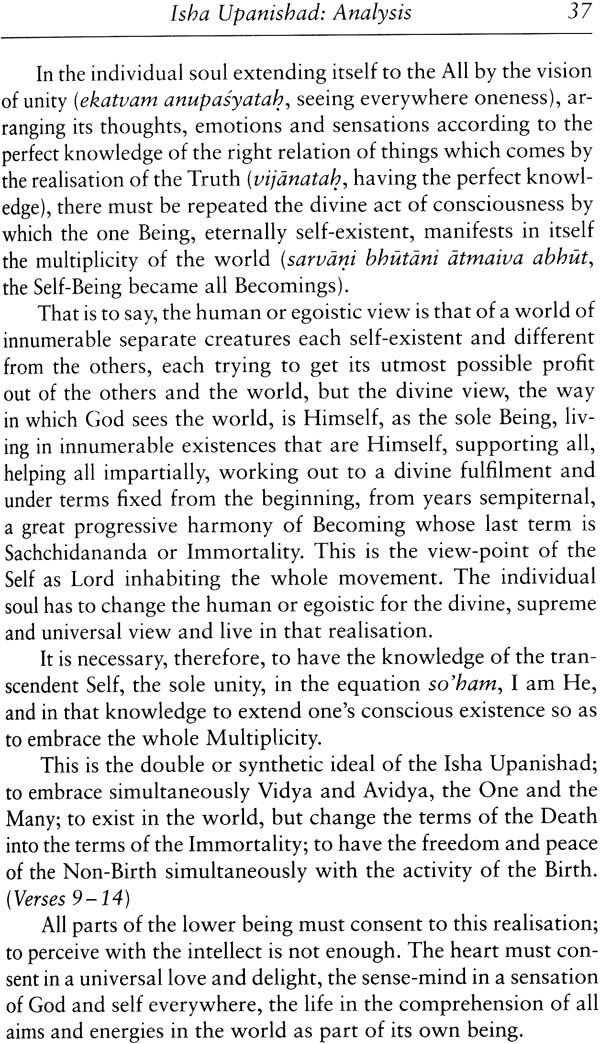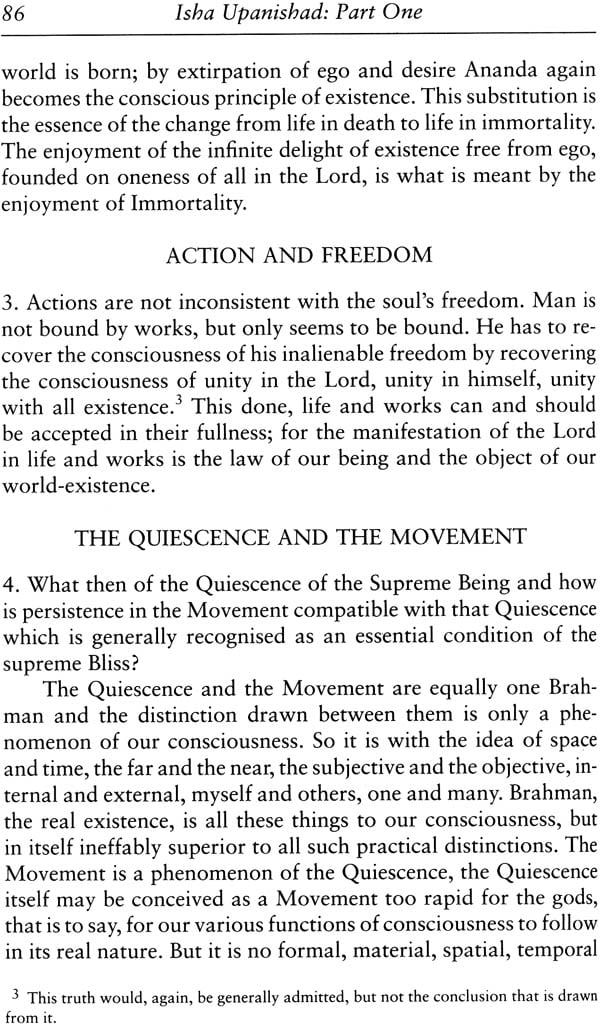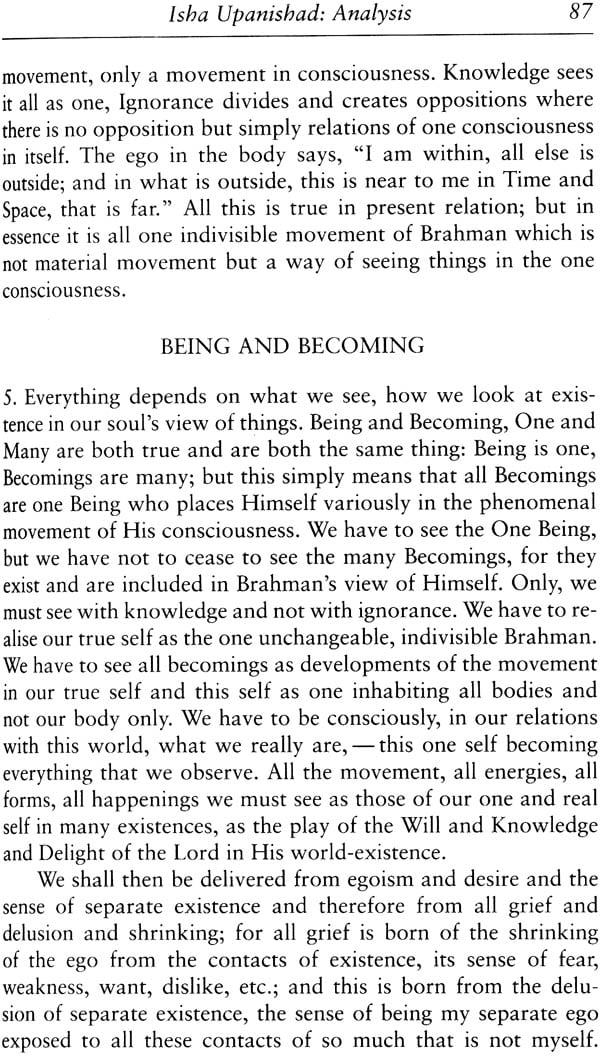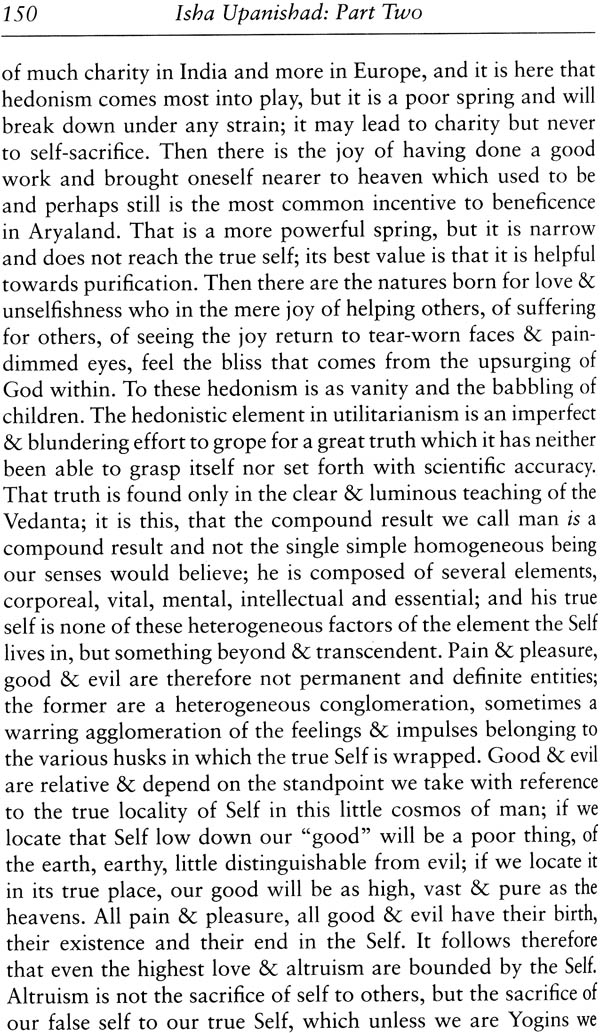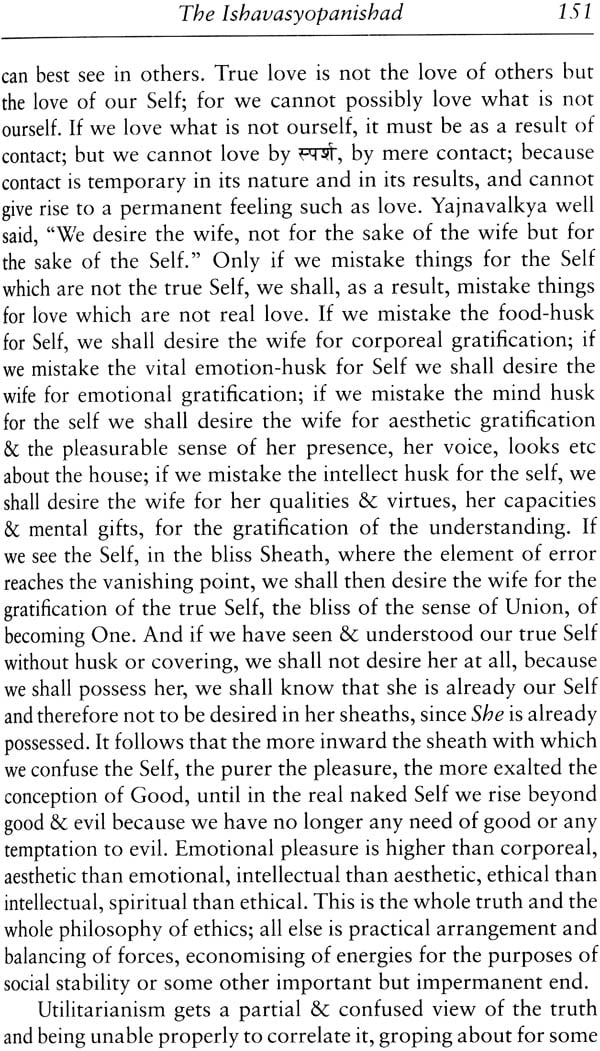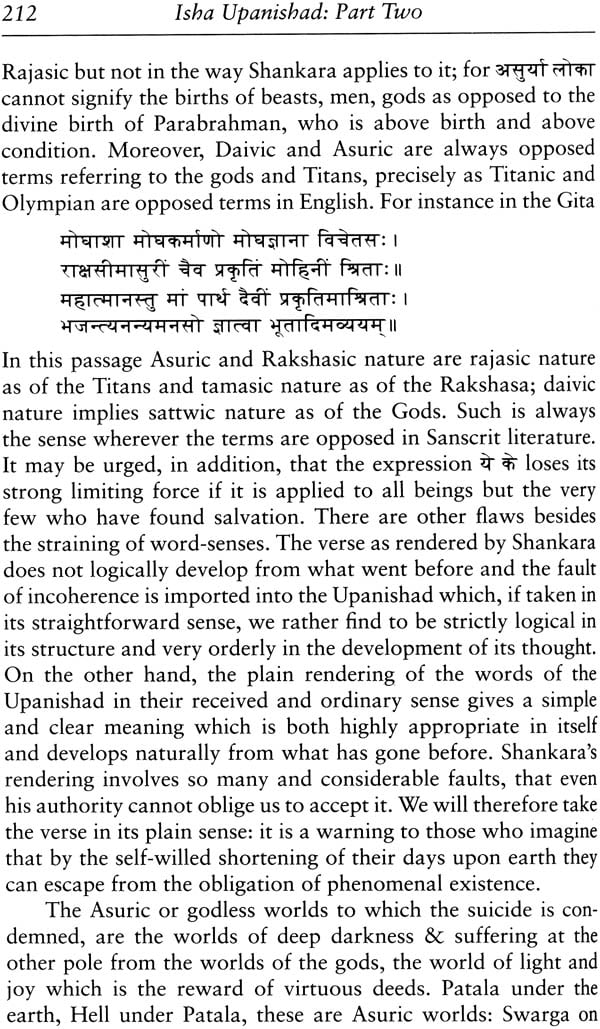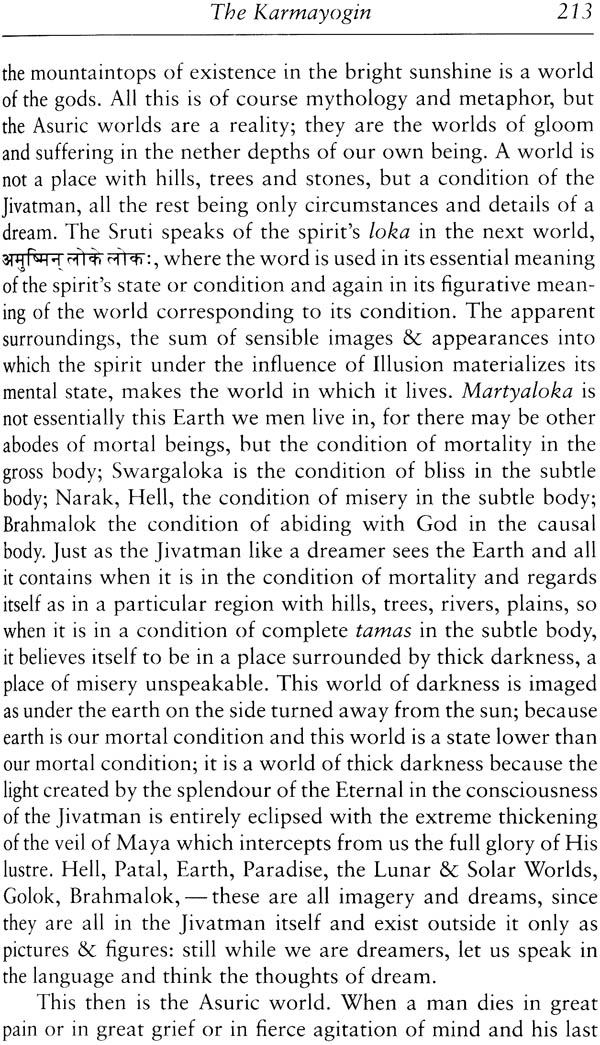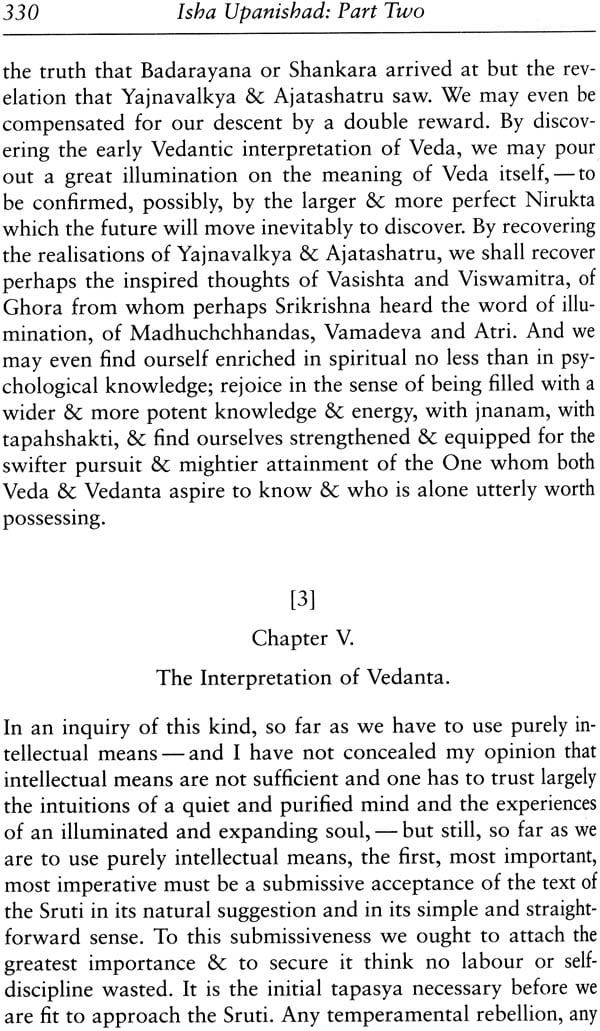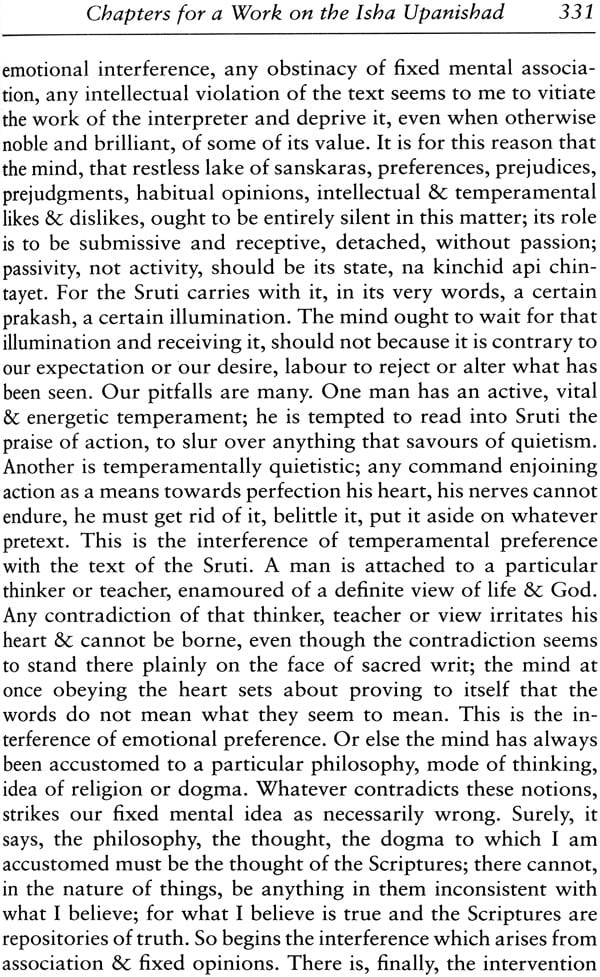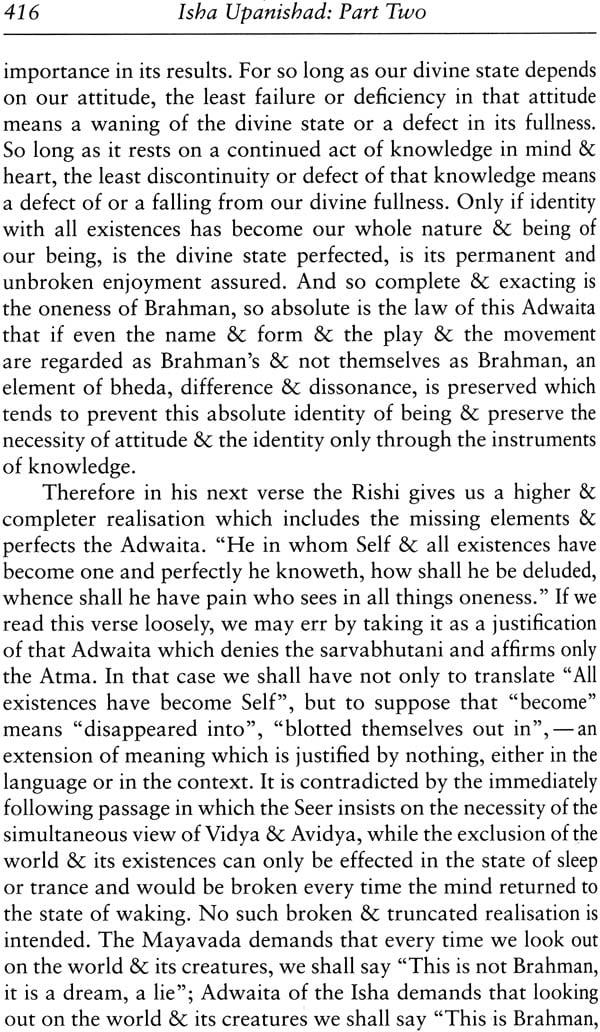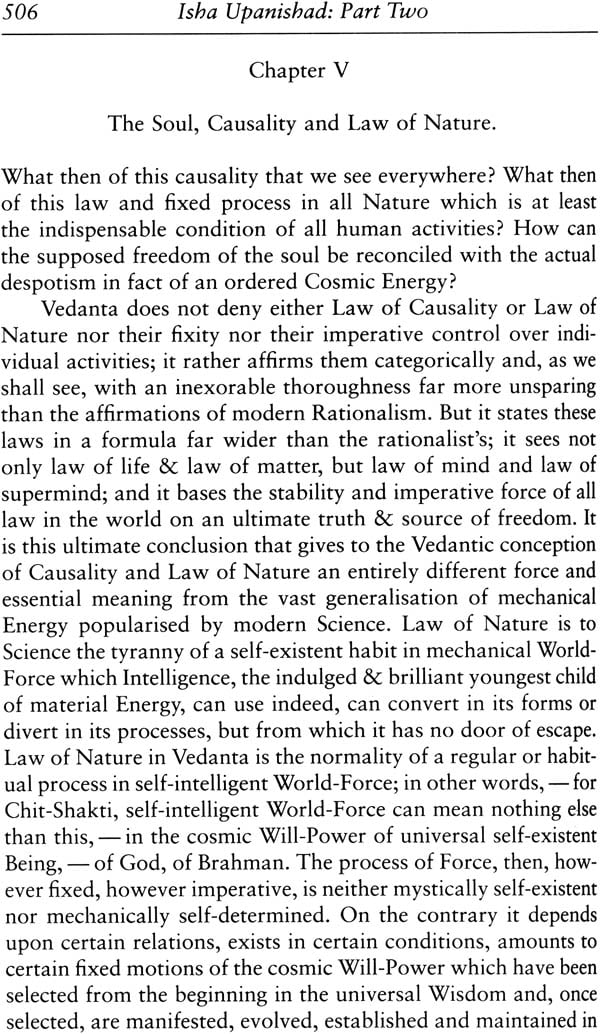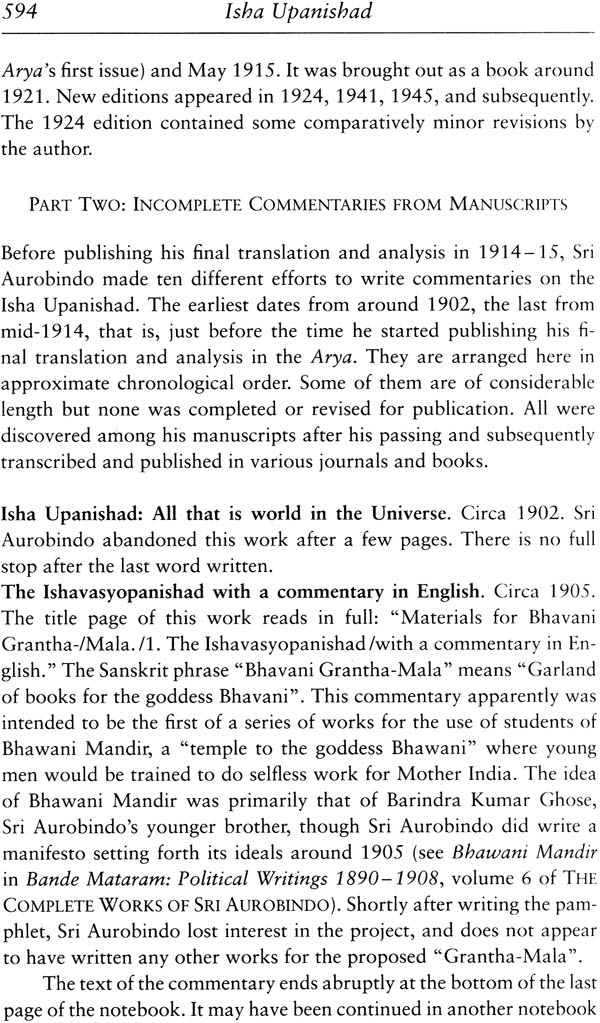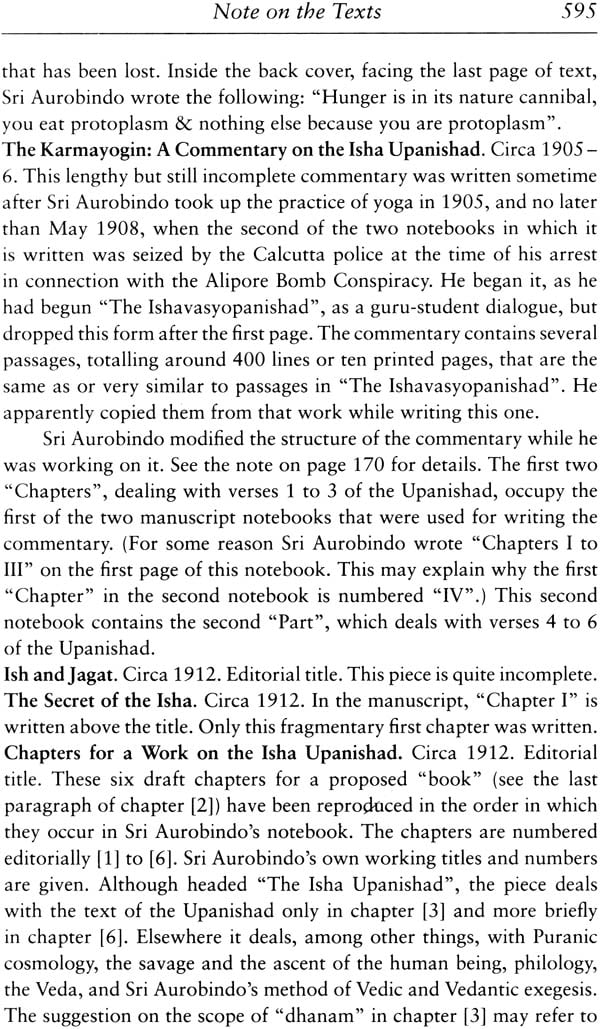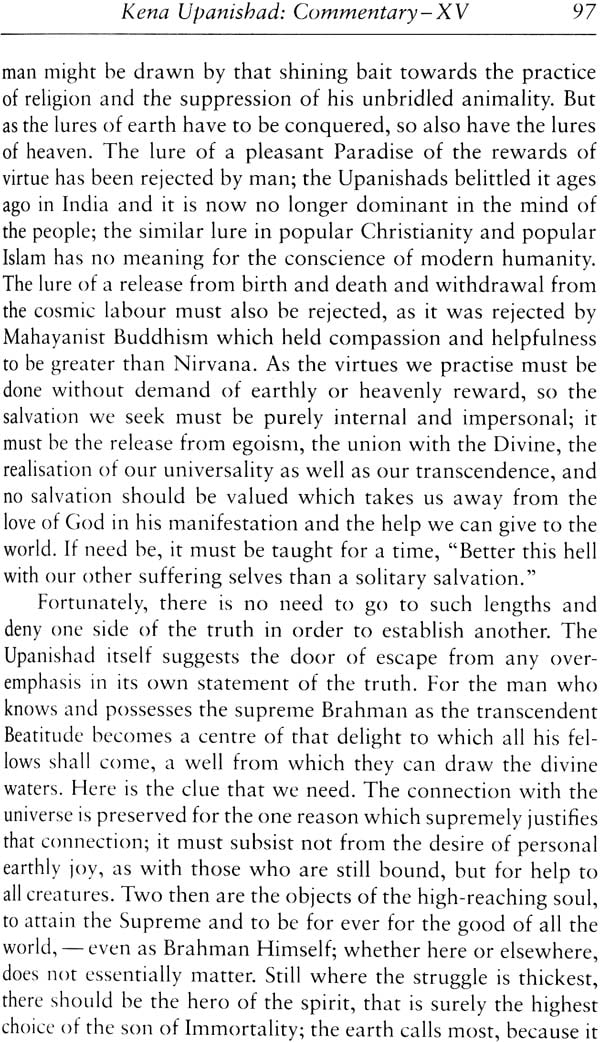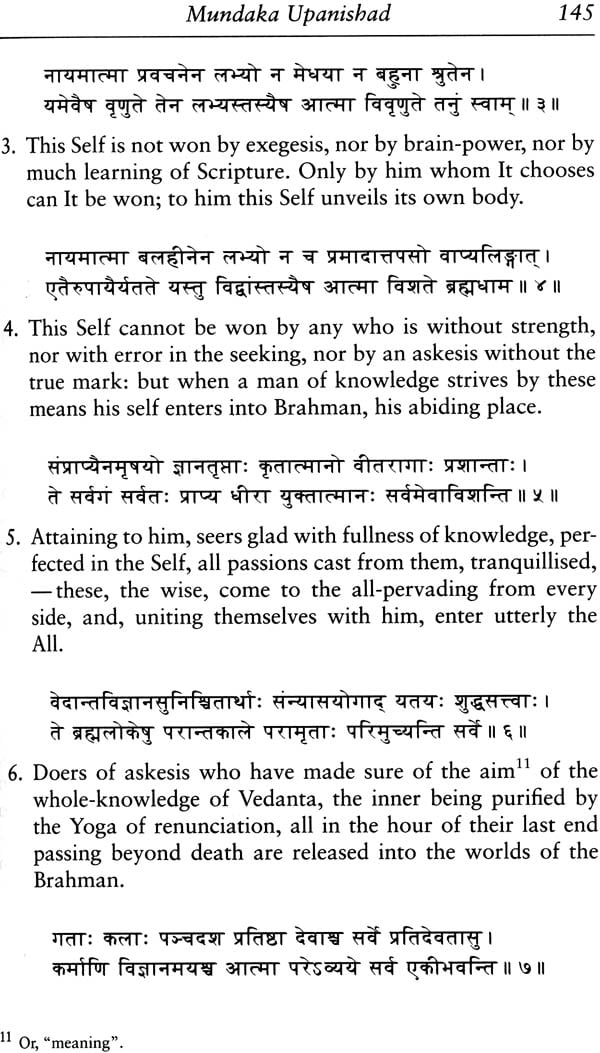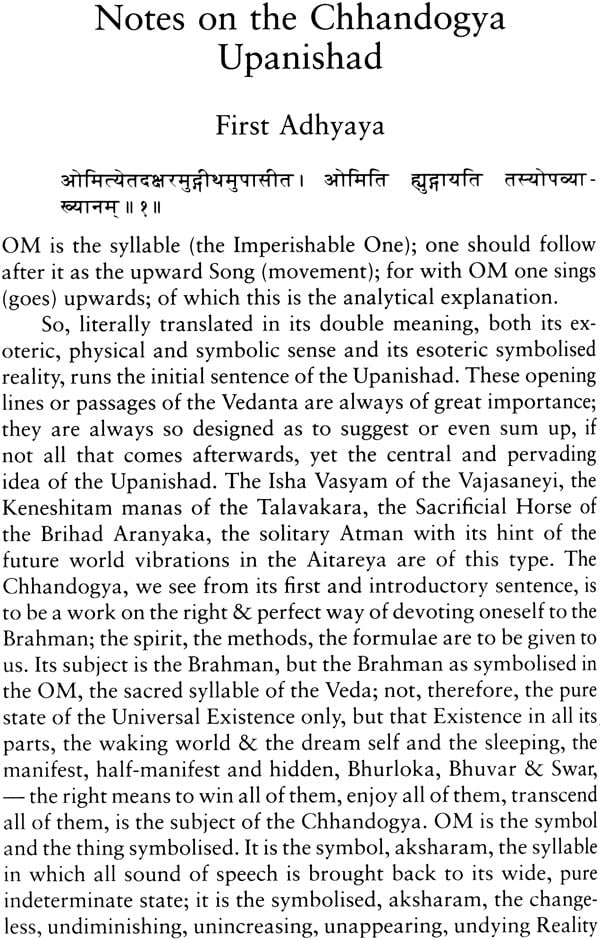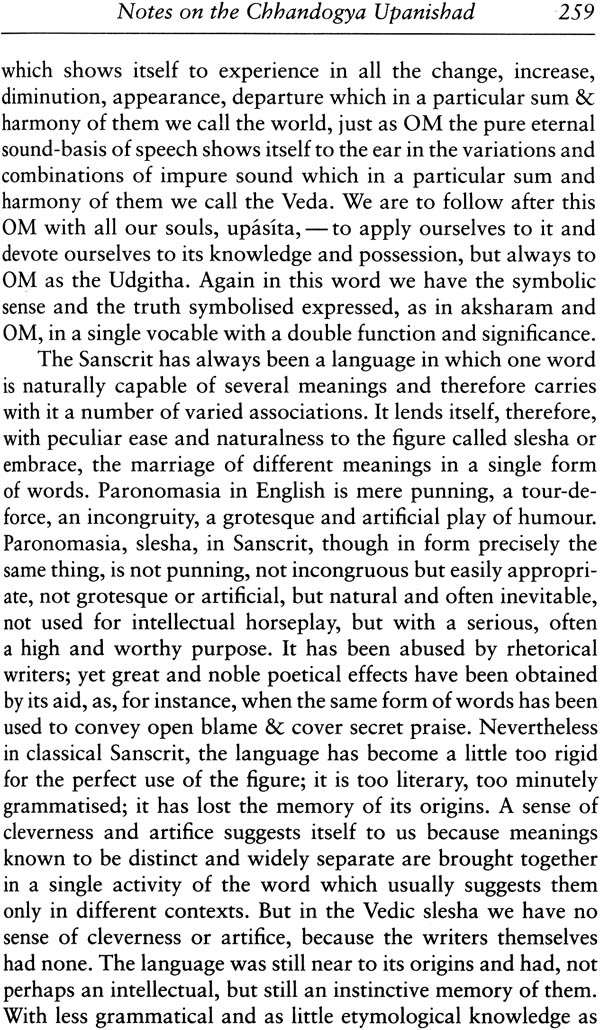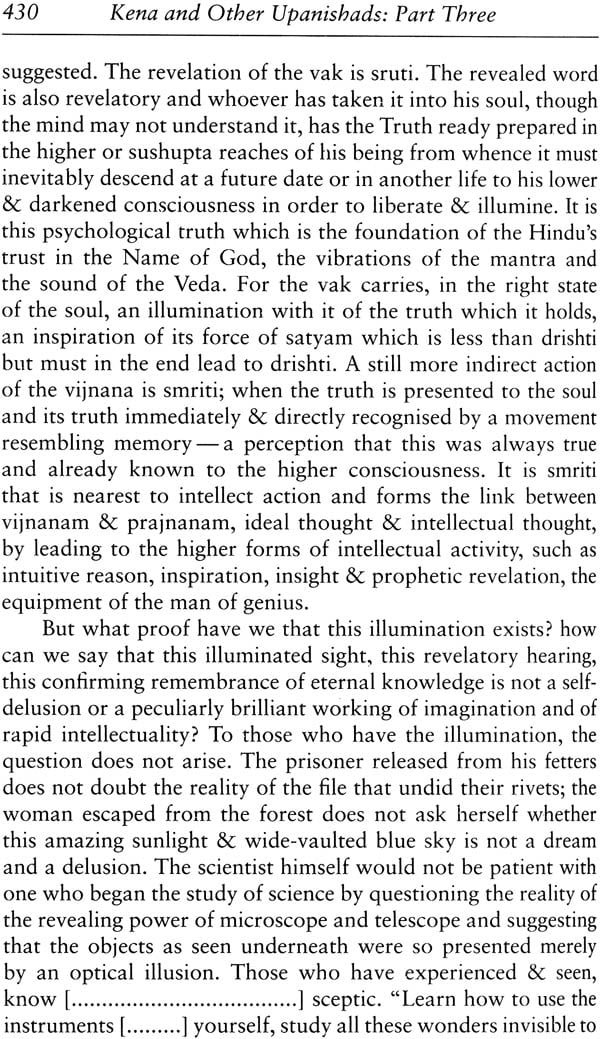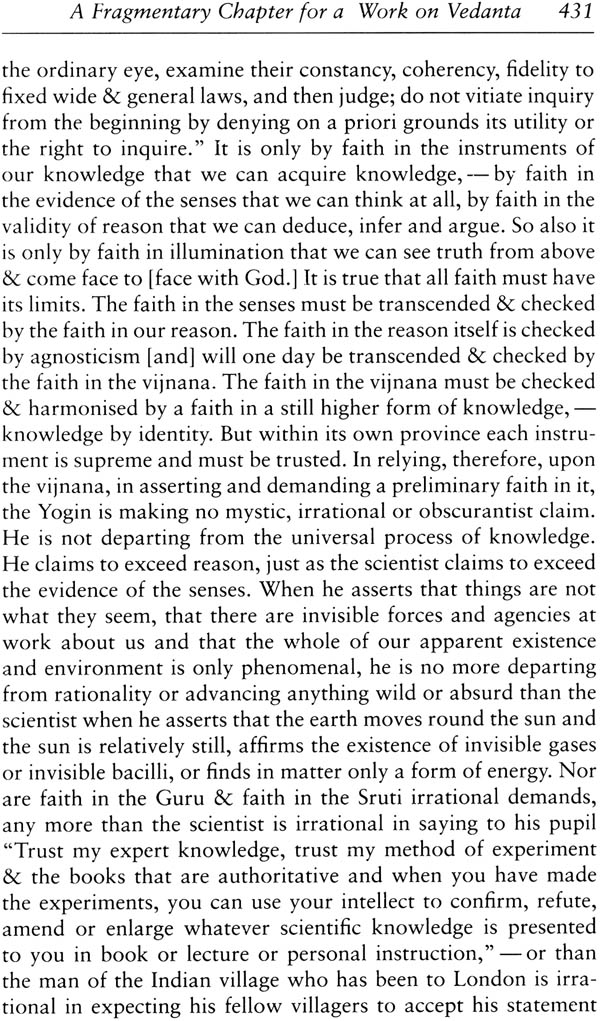
The Upanishads - Isha , Kena and Other Upanishads (Set of 2 Volumes)
Book Specification
| Item Code: | NAK701 |
| Author: | Sri Aurobindo |
| Publisher: | Sri Aurobindo Ashram, Pondicherry |
| Language: | English |
| Edition: | 2012 |
| ISBN: | 9788170587491 |
| Pages: | 1060 |
| Cover: | Paperback |
| Other Details | 8.5 inch X 5.5 inch |
| Weight | 1.40 kg |
Book Description
Vol-I
“The Isha Upanishad is the gospel of a divine life in the world and a statement of the conditions under which it is possible and the spirit of its living” writers Sri Aurobindo in one of the commentaries that make up this book. He had a special interest in this Upanishad, and translated and commented on it a number of time before presenting his final interpretation in a terse, 75-page analysis. In the present volume that final translation and analysis are followed by ten earlier commentaries. All of them help us understand “the object of our existence, which is to manifest. The glory of the divine Life and the divine Being.”
Sri Aurobindo was born in Calcutta on 15 August 1872. At the age of seven he was taken to England for his education. He studied at St. Paul's School, London, and at King's College, Cambridge. Returning to India in 1893, he worked for the next thirteen years in the Princely State of Baroda in the service of the Maharaja and as a professor in the State's college.
In 1906 Sri Aurobindo quit his post in Baroda and went to Calcutta, where he became one of the leaders of the Indian nationalist movement. As editor of the newspaper Bande Mataram, he put forward the idea of complete independence from Britain. Arrested both for sedition and for treason, he was released for lack of evidence.
Sri Aurobindo began the practice of Yoga in 1905. Within a few years he achieved several fundamental spiritual realisations. In 1910 he withdrew from politics and went to Pondicherry in French India in order to concentrate on his inner life and work. Over the next forty years, he developed a new spiritual path, the Integral Yoga, whose ultimate aim is the transformation of life by the power of a supra mental consciousness. In 1926, with the help of his spiritual collaborator the Mother, he founded the Sri Aurobindo Ashram. His vision of life is presented in numerous works of prose and poetry, among the best known of which are The Life Divine, The Synthesis of Yoga, Essays on the Gita and Savitri. Sri Aurobindo passed away on 5 December 1950.
This volume contains Sri Aurobindo's translations of and commentaries on the Isha Upanishad. His translations of and commentaries on other Upanishads and Vedantic texts, and his writings on the Upanishads and Vedanta philosophy in general, are published in Kena and Other Upanishads, volume 18 of the Complete Works of Sri Aurobindo.
The present volume is divided into two parts. The first consists of Sri Aurobindo's final translation and analysis of the Isha Upanishad. This is the only work in this volume that was published during his lifetime. It contains his definitive interpretation of the Isha Upanishad.
Before publishing this final translation and analysis, Sri Aurobindo wrote ten incomplete commentaries on the Isha Upanishad. These appear in approximate chronological order in Part Two. Ranging in length from a few pages to more than a hundred, they show the development of his interpretation of this Upanishad from around 1900 to the middle of 1914, when he began work on his final translation and analysis.
The texts in both parts have been checked against the relevant manuscript and printed versions.
| Part One | Translation and Commentary Published by Sri Aurobindo | |
| Isha Upanishad | 3 | |
| Part Two | Incomplete Commentaries from Manuscripts | |
| Isha Upanishad: All that is world in the Universe | 95 | |
| The Ishavasyopanishad with a commentary in English | 101 | |
| The Karmayogin: A Commentary on the Isha Upanishad | 169 | |
| Ish and Jagat | 303 | |
| The Secret of the Isha | 307 | |
| Chapters for a Work on the Isha Upanishad | 311 | |
| The Upanishad in Aphorism | 351 | |
| The Life Divine [Draft A] | 361 | |
| The Life Divine [Draft B] | 429 | |
| The Life Divine [Draft c] | 551 |
The Kena Upanishads is concerned “with the relation of mind-consciousness to Brahman-consciousness,” writes Sri Aurobindo in his commentary on this work. “The material world and the physical life exist for us only by virtue of our internal self and our internal life. According as our mental instruments represent to us the external world, according as our vital force in obedience to the mind deals with its impacts and objects, so will be our outward life and translation of and commentary on the Kena, this book includes hi translations of six other Upanishads as well as several other translations and commentaries, and essays such as The Philosophy of the Upanishads.
This volume comprises Sri Aurobindo's translations of and commentaries on Upanishads other than the Isha Upanishad. (His writings on that Upanishad appear in Isha Upanishad, volume 17 of The Complete Works of Sri Aurobindo.) It also includes his translations of later Vedantic texts and writings on the Upanishads and Vedanta philosophy in general.
The volume is divided into three parts. The first consists of translations and commentaries that were published during Sri Aurobindo's lifetime. The pieces in this part, along with his final translation of and commentary on the Isha Upanishad, are his most mature works of Upanishadic interpretation. The second and third parts consist of material from Sri Aurobindo's manuscripts. The second includes early translations of the Prashna, Mandukya, Aitareya and Taittiriya Upanishads, and incomplete translations of and commentaries on some other Upanishads and Vedantic texts. The third part comprises incomplete and fragmentary writings on the Upanishads and Vedanta in general.
All the texts have been checked against the relevant manuscript and printed versions.
| Part One | Translations and Commentaries Published by Sri Aurobindo | |
| Kena Upanishad | 3 | |
| Katha Upanishad | 99 | |
| Mundaka Upanishad | 129 | |
| Readings in the Taittiriya Upanishad | 149 | |
| Part Two | Translations and Commentaries from Manuscripts | |
| Section One. | Introduction | |
| On Translating the Upanishads | 163 | |
| Section Two. | Complete Translations (circa 1900-1902) | |
| The Prusna Upanishad of the Athurvaveda | 175 | |
| The Mandoukya Upanishad | 193 | |
| The Aitereya Upanishad | 197 | |
| Taittiriya Upanishad | 206 | |
| Section Three. | Incomplete Translations and Commentaries (circa 1902-1912) | |
| Svetasvatara Upanishad | 235 | |
| Chhandogya Upanishad | 250 | |
| Notes on the Chhandogya Upanishad | 258 | |
| The Brihad Aranyak Upanishad | 268 | |
| The Great Aranyaka: A Commentary on the Brihad Aranyak Upanishad | 273 | |
| The Kaivalya Upanishad | 288 | |
| Nila Rudra Upanishad | 290 | |
| Section Four. | Incomplete Commentaries on the Kena Upanishad (circa 1912-1914) | |
| Kena Upanishad: An Incomplete Commentary | 297 | |
| A Commentary on the Kena Upanishad | 311 | |
| Three Fragments of Commentary | 313 | |
| Kena Upanishad: A Partial Translation with Notes | 315 | |
| Section Five. | Incomplete Translations of Two Vedantic Texts (circa 1900-1902) | |
| The Karikas of Gaudapada | 319 | |
| Sadananda's Essence of Vedanta | 330 | |
| Part Three | Writings on Vedanta | |
| Four Fragments | 337 | |
| The Spirit of Hinduism | 340 | |
| The Philosophy of the Upanishads | 345 | |
| An Incomplete Work of Vedantic Exegesis | 400 | |
| The Religion of Vedanta | 413 | |
| Evolution in the Vedantic View | 414 | |
| The Means of Realisation | 421 | |
| A Fragmentary Chapter for a Work on Vedanta | 424 | |
| God and Immortality | 433 |
